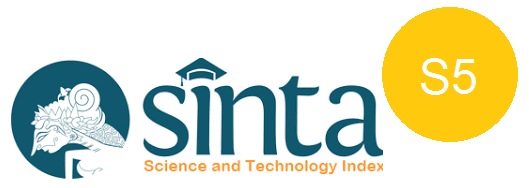VERBA PULL DALAM NOVEL PS I LOVE YOU KARYA CECELIA AHERN DAN TERJEMAHANNYA: KAJIAN SINTAKSIS DAN SEMANTIS
DOI:
https://doi.org/10.47313/pujangga.v2i1.380Abstract
ABSTRCT
This research is entitled Verba Pull dalam novel PS I love You Karya Cecilia Ahern dan Terjemahannya:
Kajian Sintaksis dan Semantis. This novel has been translated by Monica Dwi Chresnayani into Indonesian
with the same title. Syntactically, the aims of the research are to find out what elements that follow that follow
the verb „Pull‟ and whether there is syntactic shift in the target language. While semantically, it is to find out
the verb „pull‟ translation and whether there is semantics shift from the source language into the target
language. The method which is used in this research is descriptive-comparative method. The writer describes,
compares, and analyzes the source language and the target language data, and then draws a conclusion from
the analyses. Syntactically, the result of this research shows that the verb „pull‟ can be followed by some
different elements such as pull + object, pull + Preposition, pull+adverbial particle. Then, semantically, it is
found some meaning shift in the translation like the expansion meaning and enhancing meaning. In the
translation, the writer also find some words that are not translated word by word but make a word
combination, the verb „pull‟ + adverbial particles its called phrasal verbs.
Key words: verb, novel, translation, syntactic, semantic
References
Catford, J. C. 1965. A Linguistic Theory of Translation. London: Oxford University Press.
Chaer, Abdul. 2003. Linguistik Umum. Jakarta: Rineka Cipta.
-----------------. 2003. Linguistik Umum. Jakarta: Rineka Cipta.
Echols M. John and Shadily Hassan. 1992. Kamus Inggris – Indonesia. Jakarta: PT
Gramedia Pustaka Utama.
Hornby, A. S. 1975. Guide to Patterns and Usage in English. London: Oxford University
Press.
---------------. 2000. Oxford Advance Lerarner‟s Dictionary of Current English. London:
Oxford University Press.
House, Hormen and Harman, Susan. 1950. Descriptive English Grammar. Englewood
Cliffs New Jersey: Prentice–Hall, Inc.
Jacobs, Roderick A. 1995. English Syntax: A Grammar for English Language
Professionals. London: Oxford University Press.
John, Meliie, Paulene M. Yates & Edward N. De Laney.1982.Basic Language, Message
and Meaning IV. USA: Harper and Row Publisher INC.
Kridalaksana, Harimurti. 1994. Kelas Kata dalam Bahasa Indonesia. Jakarta: PT Gramedia
Pustaka.
Leech, Geoffrey. 1989. An A-Z English Grammar and Usage in English. London: Oxford
University Press.
Murphy, Raymond. 1987. Engkkish Grammar in Use. USA: Cambridge University Press.
Nababan, Rudolf. 1999. Teori Menerjemahkan Bahasa Inggris. Yogyakarta: Pustaka
Pelajar.
Newmark, Peter. 1988. A Text Book of Translation. Hertfordshire: Prentice Hall
International Ltd.
O‘Grady William. 1997. Contemporary Linguistic. London & New York: Longman.
Quirk, Randolph, et al. 1985.A Comprehensive Grammar of The English Language. New
York: Longman Group Limited.
Quirk, Randolph and Greenbaum Sidney. 1973. A University Grammar of English. London:
Longman Publisher.
Richard, Jack, et al. 1976. Longman Dictionary of Applied Linguistic. England: Longman
Group Ltd.
Swan, Michael. 1995. Practical English Usage. Hongkong: Oxford University Press.
Verhaar. 2001. Asas-Asas Linguistik Umum. Yogyakarta: Gajah Mada University Press.









